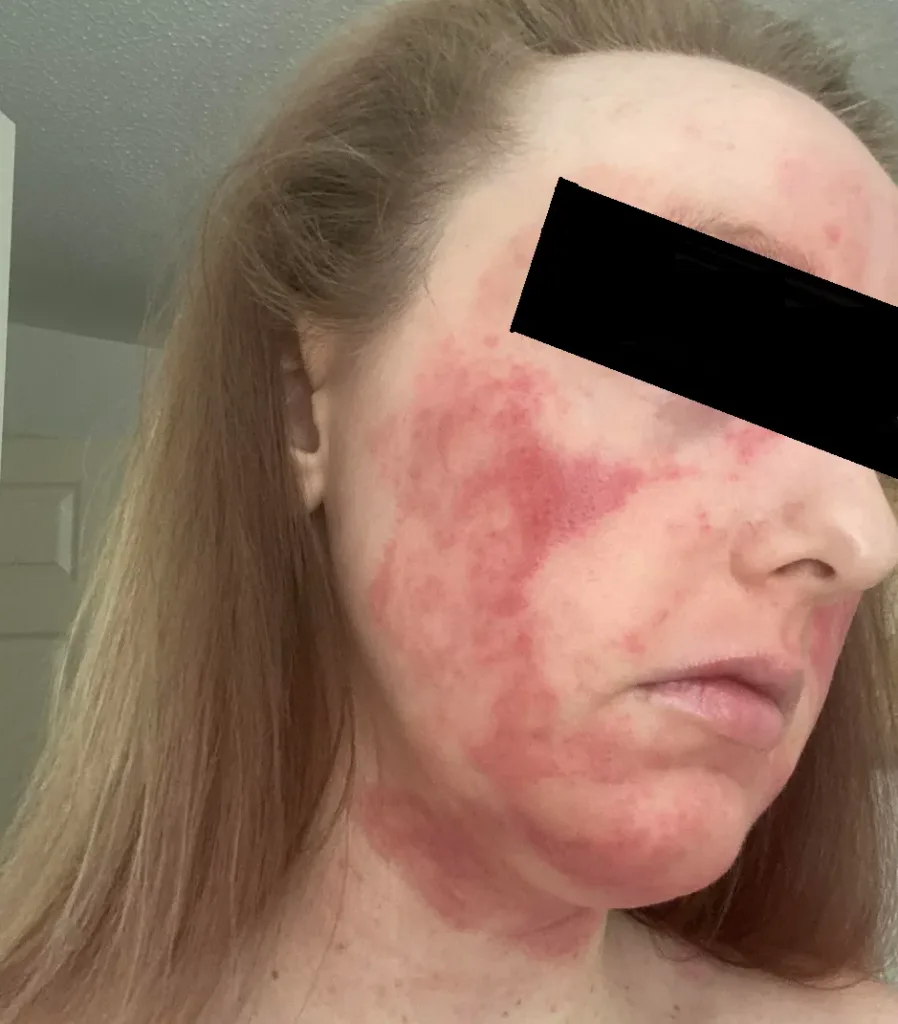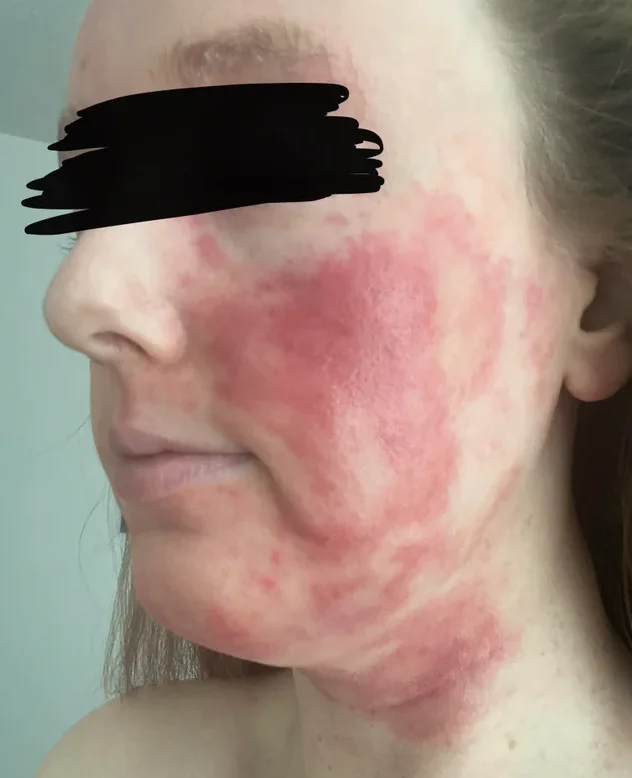Dupixent Side Effects Red Face or Dupilumab Facial Redness (DFR) is an emerging side effect of Dupilumab therapy. Since it affects the face, neck, and upper parts of the body, it is disturbing.
Treatment discontinuation requires the patient to make a tough decision since Dupixent clears most of the skin lesions. However, in some cases, it may be transient, and Dupixent withdrawal may not be required.
Furthermore, Dupixent Facial Redness improves with some of the commonly used medications such as antifungals, hydroxychloroquine, minocycline, topical corticosteroids, and topical calcineurin inhibitors.
What is Dupixent (Dupilumab)?
Dupixent is a novel class of biological medicines that is used primarily to treat patients with moderate to severe asthma, atopic dermatitis, and nasal polyps. It has also been recently approved for the treatment of eosinophilic esophagitis.
Dupixent works by depleting Th2 cells. It does so by inhibiting the Interleukin 4 receptor alpha complex. This receptor is the primary target of IL-4 and IL-13.
Hence, targeting IL-4Rα inhibits the functions of the two strong inflammatory mediators, IL-4 and IL-13.
By depleting Th2 cells, it may reduce most allergic symptoms that are mediated by basophils, mast cells, and eosinophils, but on the other hand, it also disturbs the balance between Th1 and Th2 cells.
Hence, immune activation in other areas may become more active. This is one of the mechanisms underlying the emerging side effects of Dupilumab, i.e. Facial Redness.
Dupixent Side Effect: Red Face (Dupilumab Facial Redness):

Although Dupixent is a very potent and effective treatment of atopic dermatitis (eczema), because it alters the immune pathways, the emergence of rare side effects is possible.
One rare side effect of Dupixent is redness of the face. Not much is yet known about why patients may develop redness of the face, but cases have been reported.
Dupixent Side effects Red Face in a young female:
One young female patient who was receiving treatment for atopic dermatitis with Dupixent every two weeks, developed facial redness every time after Dupixent administration [Ref].
Although with Dupixent her eczema of the hands and other parts of the body dramatically cleared, she would develop transient facial redness after Dupixent administration. Her facial erythema after Dupixent would last for about a week and then resolve.
It was also noteworthy that the facial redness spared the nasolabial folds.
The patient was then investigated and found to have SLE (systemic lupus erythematosus). She had a speckled pattern of positive antinuclear antibodies (ANA) and antiphospholipid antibodies.
To rule out drug-induced lupus, anti-histone antibodies were done, which were negative. However, the possibility of drug-induced lupus (DIL) with negative anti-histone antibodies, a novel entity, could still not be ruled out. She also had low complement levels.
Treatment of Dupixent-induced facial redness:
Since, as per the SLICC criteria, she was labeled as a case of SLE, her facial redness was treated with hydroxychloroquine. She also received low-dose aspirin as she was positive for antiphospholipid antibodies as well.
The authors suggested the following mechanisms underlying Dupixent-associated facial redness:
- Patients may have worsening atopic symptoms following Dupixent use
- The use of Dupixent may lead to the withdrawal of immune suppressants and corticosteroids, which could lead to facial redness and flare of facial symptoms
- Patients might be allergic to the drug and develop a concomitant allergic contact dermatitis
- Patients might develop seborrheic dermatitis or another form of eczema, or
- Facial redness could be part of the rare side effects of Dupixent.
Dupixent-treated patient diagnosed with erythrodermic psoriasis:
Another patient who developed redness of the body and face following Dupixent use was later diagnosed as a case of erythrodermic psoriasis.
It is possible that Th2 blockade by Dupixent could shift the immune responses from Th2 to Th1-mediated activation of IL-17 and other inflammatory cytokines.
Activation of these cytokines can result in the emergence of new disease entities such as Dupilumab-induced erythrodermic psoriasis and anti-histone-negative DIL (drug-induced lupus) [Ref]
Another possible mechanism of Dupilumab-associated facial redness is Malassezia furfur hypersensitivity.
This mechanism is backed by the improvement in patient symptoms when treated with antifungals such as itraconazole [Ref].
Dupixent Side Effects: Facial Redness: A case series of 4 patients:
Another case series of four patients who had Dupilumab Facial Redness included young patients aged 18, 22, 37, and 43 years. Three of them were females.
The onset of Dupilumab facial redness was 17, 20, 25, and 27 weeks after Dupilumab treatment initiation.
All the patients were treated with minocycline and topical calcineurin inhibitors. Three of the patients also received topical corticosteroids [Ref].
Dupixent Facial Redness: A case series of 11 patients:
In another case series of 11 patients who had Dupilumab facial redness, most had mild symptoms. 9 of the 11 patients were receiving treatment for atopic dermatitis, while 2 were receiving treatment for dyshidrotic eczema.
The authors of the case series proposed four possible theories of Dupilumab facial redness [Ref]:
- Allergic reaction or hypersensitivity reaction to Dupilumab
- Site-specific treatment failure
- Seborrheic dermatitis-like reaction to Malassezia furfur
- A paradoxical flare of atopic dermatitis.
Dupixent Side effects: Facial Redness: A systematic review:
Another systematic review of 16 studies included 101 patients who developed Dupixent-associated facial and neck erythema.
About half of the participants had baseline involvement of the face and neck, while half of them had atopic dermatitis of the body other than the face and neck.
The three commonly used medications to treat Dupixent Facial Redness were:
- Topical Corticosteroids
- Topical Calcineurin inhibitors, and
- Antifungals.
Among the 57 patients whose data were available, improvement was observed in 29 patients, 4 patients had a clearance of the lesions, 16 patients had no response, and 8 patients had worsened symptoms.
11% of the patients had to discontinue Dupixent treatment because of facial redness [Ref]
In conclusion:
Facial redness is an emerging side effect of Dupilumab (Dupixent) treatment. The cause of facial redness and the appropriate treatment are not yet very clear.
Most patients have a resolution of symptoms, but some patients may need to discontinue Dupixent treatment because of the worsening facial redness.

- [ HYALURONIC ACID MOISTURIZER ] With hyaluronic acid, ceramides and MVE technology for 24 hour hydration. Rich, velvety …
- [ MOISTURIZER FOR DRY SKIN ] A deficiency of ceramides in skin can often be associated with dry skin, which can feel itc…
- [ GENTLE DAILY MOISTURIZER ] For face and body or can be used as a hand cream for dry skin relief. Holds National Eczema…
- 97% Pure Berberine Powder – High-purity, plant-derived extract with a rich yellow color. Carefully processed and lab-tes…
- Naturally Bitter Taste – Berberine has a strong, naturally bitter flavor. Best enjoyed when mixed with smoothies, tea, c…
- 100g in Resealable Foil Pouch – Packaged in a premium aluminum pouch to protect from moisture and light, keeping the pow…

- 5 Delicious Flavors: Freeze-Dried Mango, Freeze-Dried Blueberry, Freeze-Dried Orange, Freeze-Dried Dragon Fruit & Freeze…
- Pure and Natural Ingredients: Our fruit powders are made without synthetic pesticides, GMOs, or harmful chemicals. Each …
- Health Benefits: Our carefully selected fruits are packed with antioxidants, vitamins, fiber, and digestive enzymes to s…








